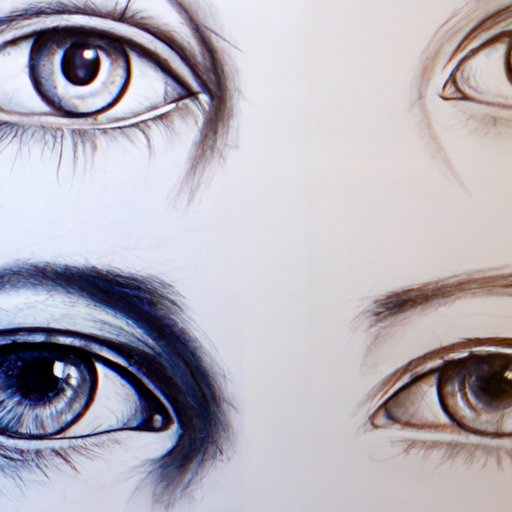
Introduction
Drawing eyes can be a challenging task for many artists, but with the right techniques and practice, it can be mastered. Realistic eyes can add depth and personality to your sketches, and capture the attention of your audience. In this article, we’ll explore a step-by-step guide, visual references, tips and tricks, advice from the experts, and exercises to help you draw realistic eyes that will make your art stand out.
Step-by-Step Guide
Breaking down the components of an eye is the first step towards mastery. Start by drawing the basic shape of an eye, including the sclera, iris, pupil, eyelashes, and eyelids. Pay close attention to the size and shape of each component, and how they all fit together.
Draw the iris as a circle with a smaller circle inside, representing the pupil. Shade around the iris to create a gradient effect, with the darkest area around the pupil and the lightest at the edge of the iris. Add texture and detail by drawing thin lines around the iris to represent veining.
The eyelashes should be carefully drawn with attention to their varying lengths and thickness. The top and bottom eyelids should be sketched, with the top lid being heavier than the bottom. The tear duct and eye socket can also be added for added realism.
Remember to keep your lines light and focus on accuracy. Erase any lines that aren’t serving your final drawing before proceeding to the next step in the process.
Visual Reference
Using visual references can be incredibly helpful when it comes to drawing eyes. Find images of eyes that you like, and use them as a guide for your own drawing. It’s important to understand the anatomy of the eye, so use visual references to study how the iris, pupil, and eyelids interact with each other.
Try drawing your references and making notes about the details that you think are important. Use the reference images as a starting point, and modify them to create your own unique style and interpretation.
One good practice to try is breaking down visual references into shapes by overlaying them with basic shapes. This can help you understand how the various parts of the eye work together, and help you create a more realistic final product.
Tips and Tricks
One helpful tip when shading is to draw in the highlights first. This helps to keep the highlight areas from being overwhelmed by the shadows. To create depth and dimension, use a series of light parallel lines across the iris to represent the reflection off the eye’s surface. Add shading around the eyelids to create depth, and use extra pressure on your pencil to create darker shadows.
Another trick to try is outlining the eye with a darker pencil to create a more finished look. Adding a small amount of white to the bottom of the iris also helps to create a more realistic reflective effect.
Don’t be afraid to experiment with texture. Using different pencils, papers, and other materials can create interesting effects that add uniqueness to your work. Hatching and crosshatching can also add depth and interest, especially for beginners.
Learn from the Experts
Some of the best tips and techniques can be learned from artists who specialize in drawing realistic eyes. Professional artists and tutors often have specific strategies and tricks that are invaluable to amateurs and professionals alike.
Introducing yourself to artists who are experts in their field, attending workshops or online classes, reading books and other sources of art education, or watching tutorials that you find online can help you learn new skills, techniques, and best practices.
Putting It into Practice
Practice is the key to success when it comes to drawing realistic eyes. Try different positions, lighting sources, and emotions to capture a broad range of styles and expressions. Draw multiple eyes to get familiar with the process, and experiment with different facial elements, arrangements, and poses. Explore creative twists, by creating fictional characters and settings.
If you’re looking to sharpen your skills and continue growing as an artist, try sketching reminders to draw how-to or techniques on sticky notes, organizing drawing work with other artists, or drawing designs on envelopes or other surfaces.
Conclusion
We hope that this guide has helped you learn how to draw realistic eyes. Remember to be patient and remain focused on the details. Keep practicing, exploring new techniques, and don’t hesitate to seek out advice from the experts. The more you draw and experiment, the more likely you are to produce eye-catching work that inspires the imagination and leaves a lasting impression.





